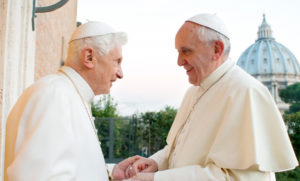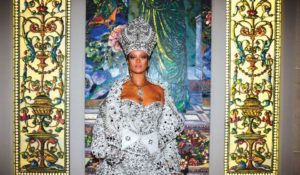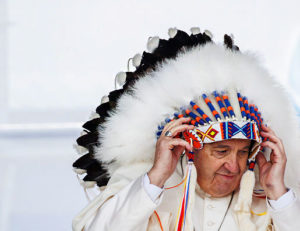In the early hours of January 2, the fully robed body of Pope Emeritus Benedict XVI was transferred from the little monastery in the Vatican where he had died on the last day of 2022 to St Peter’s Basilica. There is a photograph of his remains being lifted into a vehicle. It’s shocking, but not because it shows a dead ex-pope. It’s true that today’s megapixel cameras conveyed the waxwork sheen of the corpse in unnerving detail, but that was more obvious when Benedict was lying in St Peter’s (and, anyway, we British are squeamish because we don’t open the casket for mourners).
No: the shocking thing about that photo is that Benedict XVI, the greatest Catholic theologian of the 20th century as well as a revered pontiff, is being loaded into a white van. OK, so it’s an undertaker’s vehicle, and everyone is behaving with due reverence, but what was the Vatican thinking? The optics are terrible: Benedict looks like a piece of furniture. It’s hard to escape the suspicion that Pope Francis’s staff didn’t think Benedict merited a ceremonial hearse. At the Requiem Mass, Francis preached a homily in which he mentioned his predecessor’s name only once, and couldn’t be bothered to attend the interment in the crypt. Even the Vatican correspondent Robert Mickens, a veteran critic of Benedict’s, wrote that the Pope Emeritus “deserved better”. Cardinals from around the world were horrified.
Now Francis is paying the price. No sooner was Benedict in his grave than we felt the first tremors of an earthquake that threatens to bury his successor alive. The Catholic civil war has entered a new phase. The Pope has been accused by his enemies of favouring heretics, foul-mouthed outbursts of temper, sucking up to dictators, sadistic manoeuvres against traditionalists, perverting the course of justice, a feeble grasp of Catholic doctrine and — not for the first time — of protecting a sex abuser. Catholic conservatives had been worried for years that when the ancient ex-pope finally died, Francis would be free to pursue his own agenda. For nearly 10 years he stopped short of formally changing Catholic teaching on divorce and homosexuality, restricting himself to giving a nudge and a wink to hardline liberals while missing no opportunity to give traditionalists a kicking.
In a development that would have been unthinkable 30 years ago, Latin Mass parishes and communities are attracting disproportionate numbers of young priests and worshippers. Some of them cultivate a fogyish, holier-than-thou manner that gets up the nose of ordinary Catholics — but most of them are breathing new life into a moribund Church. Pope Francis loathes them. In 2020, with no warning, he banned many of their Latin Masses, and according to multiple sources, at a meeting with seminarians in December he ranted against “fucking careerists who fuck up the lives of others”. In his defence, perhaps the words were less vulgar in Spanish. Then again, it’s no secret in the Curia that the air turns blue when the Vicar of Christ is displeased.
With his scholarly predecessor finally dead, the thinking went, the Argentinian Pope could really let rip. And so his conservative critics decided to get their revenge in first. Benedict’s private secretary Archbishop Georg Gänswein landed a blow within hours of his boss’s death. The ex-pope, he said, was “heartbroken” by Francis’s Latin Mass ban, and no wonder: it was Benedict who reintroduced the old liturgies in his 2007 apostolic letter Summorum Pontificum. On January 12, Gänswein rushed out a book, Nothing But the Truth, which claimed that Benedict thought Francis had misrepresented his reasons for issuing the document. It also hinted that he felt his successor was adopting a dangerously careless approach to Catholic teaching on sexuality.
In the same week came more bombshells. To the anguish of the Church’s conservative wing, Cardinal George Pell, former head of Vatican finances, died suddenly after a routine operation on January 10. A few hours later, The Spectator published an article by Pell that tore mercilessly into Pope Francis’s pet project, a forthcoming “Synod on Synodality” whose agenda has been dictated by liberal Catholics who support women’s ordination and are obsessed with placating the LGBT+ lobby. Pell said the synod was shaping up to be a “toxic nightmare” and poured scorn on the working document’s “neo-Marxist jargon”.
Never before had the Australian cardinal expressed himself so bluntly — or so it seemed, until the celebrated Vatican mischief-maker Sandro Magister revealed that Pell was the author of a memo, signed “Demos”, that circulated among cardinals last year. And “blunt” doesn’t begin to describe the language Pell used when writing under a pseudonym. The cardinal — once one of Francis’s closest advisers — described this pontificate as “a disaster in many or most respects; a catastrophe”. He accused the Pope of remaining silent in the face of “heretical” voices calling for the scrapping of the Church’s ban on women priests and gay sex, while encouraging “the active persecution of traditionalists” and writing papal documents that marked an intellectual “decline” from the standards of John Paul II and Benedict XVI.
Pell warned his fellow cardinals that the Church was heading towards bankruptcy. He accused the Pope of turning the Vatican’s trial of Cardinal Angelo Becciu and other defendants on massive corruption charges into “an international scandal” by shifting the legal goalposts. That was a typical Pell touch: although Becciu had been his arch-enemy in the Curia, he had himself been the victim of a grotesque miscarriage of justice when he was jailed in Australia on false charges of sex abuse, and he did not want to see a fellow cardinal denied “due process”. The memo mentioned the regular phone-tapping that frightens everyone in the Curia, Francis’s habit of ruling through decrees that allow no appeals, and the Vatican’s betrayal of Chinese and Ukrainian Catholics. “The Holy Father has little support among seminarians and young priests,” it added.
Pell would have been amused to watch Francis’s dwindling band of admirers jump like scalded cats when the authorship of the Demos memo was revealed. Given that he had died the day before, they couldn’t savage his memory; nor could they challenge the damningly precise detail in the memo; and perhaps some of them realised that George Pell had never been a traditionalist and, when Francis was elected, had believed that he might be the right man for the job. His despair came from his personal dealings with the Pope, whom he came to regard as devious but dithering and, worse, not fully committed to the Catholic faith.
And then it looked as if another bombshell had landed. On January 20, Benedict XVI spoke from beyond the grave in his final book, What is Christianity?, which he hadn’t wanted published during his lifetime because anything he said provoked hysteria from German liberals. Would Joseph Ratzinger finally settle scores with Jorge Mario Bergoglio, who genuinely had humiliated him by trashing his ruling on the Latin Mass? The answer was no, as anyone who knew Benedict should have guessed. His book is a collection of essays, infinitely better written and, yes, more conservative than Francis’s writings — but the late Pope Emeritus would have considered it just as wrong to break his promise to show loyalty to his successor after his death as before it. So, nothing to see here, then.
But try looking somewhere else, to a book by Cardinal Gerhard Müller, appointed Prefect of the Congregation for the Doctrine of the Faith by Benedict and sacked without warning or explanation by Francis in 2017. Müller, a moderate conservative with liberal friends who seemed like a bridge between the two pontificates, was understandably furious. Recently he has criticised the theological incoherence of this pontificate. On January 27, a book-length interview with Müller entitled In Good Faith was published in Italy. In it, the 75-year-old German cardinal sailed closer to the wind than Pell ever did under his own name. Pope Francis, he said, surrounds himself with “a kind of magic circle… composed of people who, in my opinion, are not prepared theologically”. Papal reforms of the Curia were a disaster, reducing it to “a business that works to provide assistance to ‘clients’, the episcopal conferences, as if it were a multinational enterprise and no longer an ecclesial body”.
What makes Müller’s interview so deadly for Francis, however, is that it is the first time that a cardinal has drawn attention to the Pope’s favouritism towards clergy who have been accused of sex abuse. Müller mentions the “special status” given to Bishop Gustavo Zanchetta, an Argentinian protégé of Francis whom he made a bishop as soon he became pope. In 2017, Zanchetta had to resign from his diocese of Orán amid allegations of abusing seminarians and financial mismanagement. Francis promptly created a job for Zanchetta in the Vatican overseeing the Holy See’s property and financial assets. This jaw-dropping appointment came to an end, however, when Zanchetta was jailed in Argentina for abusing two seminarians — despite the Vatican’s mysterious refusal to supply the courts with its own investigations into the charges.
This was at least the third time Francis had stuck his neck out — and risked his reputation — to defend a Latin American ally either plausibly accused or convicted of sexual abuse. Now there are questions about what the Pope knew about another of his clergy friends — his fellow Jesuit Fr Marko Rupnik, a celebrity artist whose tacky mosaics adorn churches all over the world and in the Vatican. The Rupnik scandal beggars belief. In 2015 the Slovenian priest seduced a novice nun and then absolved her of the sin of sleeping with him in the confessional. He was convicted of this grave offence — which incurs automatic excommunication — by a church court in January 2020. But his official excommunication was not imposed until May 2020, and lifted that same month because he had repented.
In between the conviction and the official excommunication, however, Rupnik was asked to preach the Lenten homilies at the Vatican in March 2020 and Francis signed off on it. Did he really not know about Rupnik’s trial for the seduction and absolution of a novice, particularly as Rupnik had been ordered not to preach in public without permission or to hear women’s confessions as a “preliminary” measure as early as June 2019? But that’s not the worst of it. Last December, Italian websites began claiming that Rupnik was suspected of serially abusing women in the Nineties. After the reports appeared, a former religious sister gave an interview to an Italian newspaper alleging that during the Eighties and Nineties Rupnik abused half the members of a community of consecrated women he founded in Slovenia. She claimed that he demanded that she play “erotic games in his studio… while painting or after the celebration of the Eucharist or confession”. Those “games” became increasingly pornographic.
Then it emerged that in 2021 the Jesuit order had started investigating allegations by nine women, but that nothing was done because the Vatican refused to investigate them, citing its statute of limitations. In 2022, the Jesuits asked for this to be lifted because the alleged offences were so “gruesome”, but the Vatican again refused. In January 2022, Rupnik had a private meeting with Francis. We know nothing about it, but we do know that in February the Diocese of Rome posted a talk by Rupnik on Eucharistic Adoration on its YouTube channel. And for the rest of the year this celebrity priest swanned around Italy giving retreats.
Last December, the Cardinal Vicar for the Diocese of Rome, Angelo De Donatis, issued a statement claiming that Rome learned of the Rupnik allegations “only in very recent times”. It ended with the statement that his diocese was “comforted by the discernment of her Supreme Pastor”. This prompted a veteran Vatican correspondent, Christopher Altieri of Catholic World Report, to claim that De Donatis was speaking in code. “Basically, Cardinal De Donatis is telling everyone who reads and understands curialese that Pope Francis is calling the shots on this one, and that Pope Francis has Fr Rupnik’s back,” he wrote. This was just before the deaths of Benedict and Pell and the flurry of books criticising Pope Francis. Vatican-watchers forgot about the Rupnik scandal for a few days, then started asking with increasing alarm whether Francis was party to a cover-up.
The Pope seems to have panicked. On January 24, he gave a long interview in Spanish to Nicole Winfield of the Associated Press — definitely one of the safer choices for a pontiff worried about being grilled. Francis called for homosexuality to be decriminalised everywhere, which AP justifiably ran as the headline. Winfield gushed about what a milestone this was for LGBT people, while admitting that the Pope “referred to the issue in terms of ‘sin’”. In fact, he had described homosexuality as a sin, which is not the teaching of the Catholic Church. As a result, he had to write a hasty letter to the Jesuit gay rights activist Fr James Martin explaining that he meant that all sexual acts outside marriage were sinful, though “circumstances may decrease or eliminate fault”. For his critics, it was an example of Francis at his worst: a mixture of confusion, evasion and sleight of hand.
Inevitably, both sides in the Catholic civil war slugged it out over the episode — which was embarrassing for the Pope but at least deflected attention from the very slippery answer he gave when he was asked about his friend Rupnik. To quote AP: “Francis denied he had any role in the handling of Rupnik’s case, other than to intervene procedurally to keep the second set of accusations from the nine women with the same tribunal that had heard the first.” His only decision was “let it continue with the normal court, because, if not, procedural paths are divided and everything gets muddled up”. And, he added: “So I had nothing to do with this.”
This makes no sense. As Altieri points out, you can’t simultaneously claim that you intervened in a procedural matter and had “nothing to do with this”. And then there’s the fundamental question of why the Vatican was so determined to scupper a Rupnik trial by invoking a statute of limitations that Francis could easily have waived. Someone in Rome needs to do some more pushing on Francis’s protection of Zanchetta and others. And here we encounter the infuriating reluctance of accredited Vatican correspondents to subject the ruler of Western Europe’s most corrupt independent state to the scrutiny that any president or prime minister would receive.
As a result, most Catholics, and even some of the cardinals who will be voting in the next conclave, don’t know the extent of the crisis. And that’s why Cardinal Pell, with a heavy heart, wrote the Demos memo. He was doing everything in his power to ensure that the next pope was an orthodox Catholic — not something previous conclaves have had to worry about, but some of the red hats Francis has doled out have landed on the heads of clerics whose views are more liberal Protestant than Catholic. Unfortunately Pell died first, reminding us that a man regarded by countless Catholics as the worst pope for centuries has one precious asset: he’s lucky.
Disclaimer
Some of the posts we share are controversial and we do not necessarily agree with them in the whole extend. Sometimes we agree with the content or part of it but we do not agree with the narration or language. Nevertheless we find them somehow interesting, valuable and/or informative or we share them, because we strongly believe in freedom of speech, free press and journalism. We strongly encourage you to have a critical approach to all the content, do your own research and analysis to build your own opinion.
We would be glad to have your feedback.
Source: UnHerd Read the original article here: https://unherd.com/





